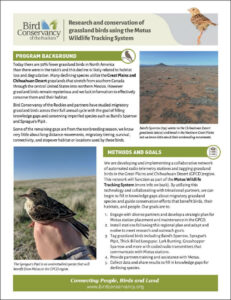Migration
Most birds don’t stay put. They migrate, often thousands of miles a year. To conserve migratory birds, we must understand where they live across their full annual life cycle. Bird Conservancy of the Rockies uses technologies, such as geolocators, stable isotopes and satellite transmitters, to track birds’ migration. That way, we can discover where they spend the winter, as well as key stopover sites along the journey.
This research includes, but is not limited to, investigations on the migrations of:
- Baird’s Sparrows and Grasshopper Sparrows breeding in the northern Great Plains
- Mountain Plovers breeding in western Nebraska
- Western Tanagers and Swainson’s Thrushes breeding in Rocky Mountain National Park
- Ospreys breeding in central Colorado
- Golden Eagles breeding in Colorado and western Nebraska
- Black Swifts breeding in Colorado
Bird Conservancy of the Rockies is studying grassland bird ecology during different parts of their full annual cycle with the goal of informing strategic conservation plans for their conservation. One of the biggest knowledge gaps exists during migration. Not much is known about specific routes used by these birds, or where they stop to rest and refuel.
The Motus Wildlife Tracking System (Motus) is a network of automated radio telemetry stations that offers an effective method to explore migratory bird movement in this region; coded radio transmitters can be attached to small-bodied birds such as Baird’s Sparrows, Chestnut-collared Longspurs, Thick-billed Longspurs, and Sprague’s Pipits to track them without the need for recapture. A network of Motus stations across the Great Plains and Chihuahuan Desert can then track these birds over time to create a new understanding of how grassland birds move throughout their life cycles. Click here to learn more about Bird Conservancy’s Motus initiative.


